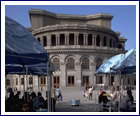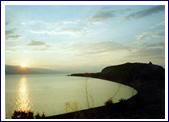The Whale shark (Rhincodon Typus) is the largest fish in the world, growing up to 12m (40 feet) in length. Though massive in size, whale sharks are completely harmless and feed on plankton and small fish which are filtered from the water as they cruise the world's oceans. Despite their size, whale sharks are remarkably gentle and curious. They have a slow growth rate, only reaching maturity at around 30 years old and living as long as 60 – 100 years. Their reproduction rate is also very slow – long intervals between pregnancies and producing around a few hundred pups at one time.
Whale Sharks are located near the Equator around coast lines and open seas. They swim mostly along the top of the surface. Whale sharks can be found in the following areas:
- Western Atlantic: New York to central Brazil and including Gulf of Mexico and Caribbean.
- Eastern Atlantic: Senegal, Mauritania, Cape Verde Islands, Gulf of Guinea.
- Indo-West and Central Pacific: South Africa and Red Sea to Pakistan, India, Sri Lanka, Malaysia, Thailand, China, Japan, Philippines, Indonesia (Kalimantan, Java, Irian Jaya), Papua New Guinea, Australia (Queensland, Northern Territory), New Caledonia, Hawaiian Islands.
- Eastern Pacific: Southern California to northern Chile.
- Indian Ocean: the Seychelles, Mauritius, Zanzibar, Madagascar, Mozambique and northernmost Natal.
Unfortunately, in some countries such as India and the Philippines, the whale shark is often hunted for meat which is sold to feed the rich in SE Asia, where whale shark meat is an expensive delicacy. Numbers have certainly been reduced, but with the migratory habits of the sharks, it is very difficult to track and count them.
February to May: The time of year to see a whale shark in Thailand is between February and May.
April to June: Whale shark sightings are extremely common on the Ningaloo Reef in the months of mid April-June. A spotter plane communicates with boats as it spots the large shadow of a whale shark near the surface. Interactions are regulated by CALM (Conservation and Land Management), which limits the number of snorkellers in the water with a shark to a maximum of 10 and does not allow the use of flash photography. There are also strictly regulated guidelines including the distance a snorkeller should stay from the animal and how long a single interaction with a whale shark may last. These measures are mainly to reduce stress to the sharks, another unknown factor for scientists, even though people have been interacting with whale sharks on the Ningaloo for many years.
April to June: southern Belize offers whale shark spotting opportunities. The best time to do so during these months are three days before the full moon to three days after the last quarter moon. It's during these times that the Cubera Snappers spawn, attracting the Whale Sharks.
July to September: Rarely seen in shallow coastal waters, whale sharks have been regular visitors to the Sea of Cortez near Bahia de Los Angeles, Baja California, Mexico are closest to the US and are a good place to encounter whale sharks at this time of year.
November to April: whale sharks can be seen around Richelieu Rock in the North Andaman Sea.
If you have had a whale shark encounter, the Beetle would love to hear from you!


 The majestic peaks of Mount Ararat provide a stunning
backdrop to Yerevan. The monastery of Khor-Virab and the ruins of
the ancient city of Dvin (dating back to the second century BC) are
located in the mid-distance Aerial view of Yerevan, capital of
Armenia Statue of Komitas, one of Armenia's most loved
composers, outside the Komitas Conservatory. Apart from writing
many original composition, Komitas travelled the country noting
down folk songs for posterity Yerevan, which is nestled in the
shadow of the snow-capped heights of the majestic mount Ararat,
where the Biblical Noah's Ark first landed escaping the Great
Flood, is the capital city of Armenia. With a population numbering
over 1.2 million, Yerevan is a bustling city. The central plaza,
Republic Square, is designed in the Armenian national style and
houses the Government House, the Cabinet and other governmental
offices as well as the Erebuni and Armenia hotels.
The majestic peaks of Mount Ararat provide a stunning
backdrop to Yerevan. The monastery of Khor-Virab and the ruins of
the ancient city of Dvin (dating back to the second century BC) are
located in the mid-distance Aerial view of Yerevan, capital of
Armenia Statue of Komitas, one of Armenia's most loved
composers, outside the Komitas Conservatory. Apart from writing
many original composition, Komitas travelled the country noting
down folk songs for posterity Yerevan, which is nestled in the
shadow of the snow-capped heights of the majestic mount Ararat,
where the Biblical Noah's Ark first landed escaping the Great
Flood, is the capital city of Armenia. With a population numbering
over 1.2 million, Yerevan is a bustling city. The central plaza,
Republic Square, is designed in the Armenian national style and
houses the Government House, the Cabinet and other governmental
offices as well as the Erebuni and Armenia hotels.
 Yerevan, the ancient capital of Armenia, extends you a
warm and friendly welcome. It is one of the oldest cities in the
world. The earliest recorded settlement there dates back to 782 BC.
King Argishty I founded a fortress city in the north-eastern part
of present-day Yerevan, with the following cuneiform inscription,
“With the majesty of God Khald, Argishty, son of Menua, built
up this inaccessible castle and named it Erebuni…” You can
still see relics from this part of our history at the Erebuni
Museum in Yerevan.
Yerevan, the ancient capital of Armenia, extends you a
warm and friendly welcome. It is one of the oldest cities in the
world. The earliest recorded settlement there dates back to 782 BC.
King Argishty I founded a fortress city in the north-eastern part
of present-day Yerevan, with the following cuneiform inscription,
“With the majesty of God Khald, Argishty, son of Menua, built
up this inaccessible castle and named it Erebuni…” You can
still see relics from this part of our history at the Erebuni
Museum in Yerevan.
 As you explore the many interesting sights in Yerevan, you will
learn about the culture and history of one of the world's
oldest nations.
As you explore the many interesting sights in Yerevan, you will
learn about the culture and history of one of the world's
oldest nations.
 Becky introduces me to my host, Mr Sijaona. He is a
small wiry man with a purposeful stride. He welcomes me into his
house. I gaze around at the crumbling walls and the total lack of
comfort. But then he says in halting English that his other house
is better, (two wives, therefore two houses) – so I pick up my
suitcase and follow him down the dusty street.
Becky introduces me to my host, Mr Sijaona. He is a
small wiry man with a purposeful stride. He welcomes me into his
house. I gaze around at the crumbling walls and the total lack of
comfort. But then he says in halting English that his other house
is better, (two wives, therefore two houses) – so I pick up my
suitcase and follow him down the dusty street.
 We are sorry to say that Mac is not very well, but he is still
e-mailing strong and recently sent the Beetle a collection of
travel reminiscences about Australia, camels which takes us to
India and then back to Australia.
We are sorry to say that Mac is not very well, but he is still
e-mailing strong and recently sent the Beetle a collection of
travel reminiscences about Australia, camels which takes us to
India and then back to Australia.
